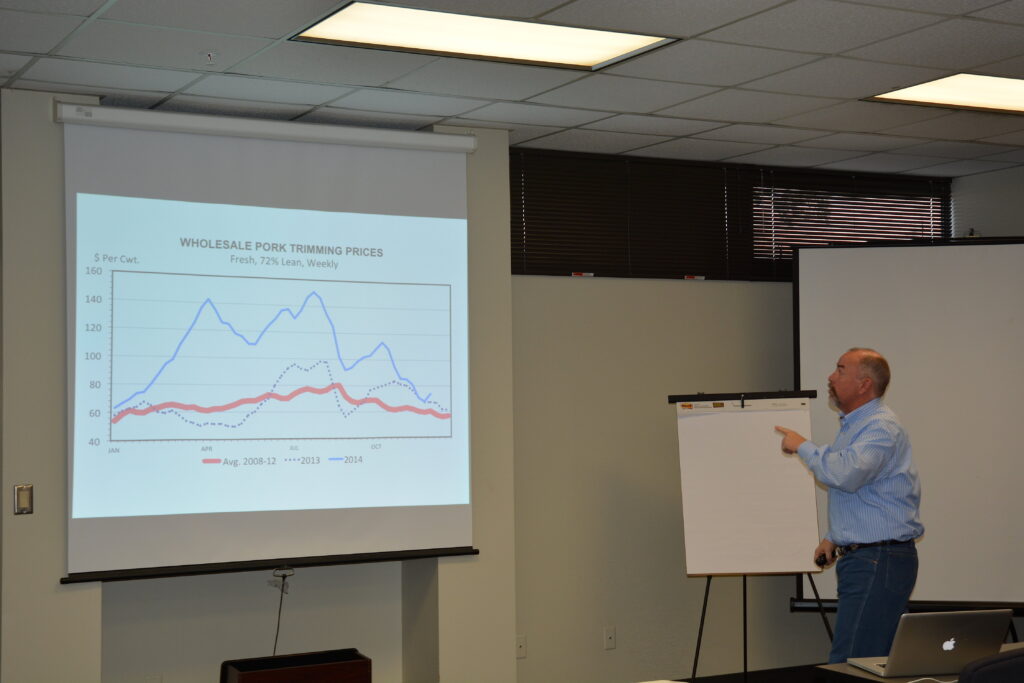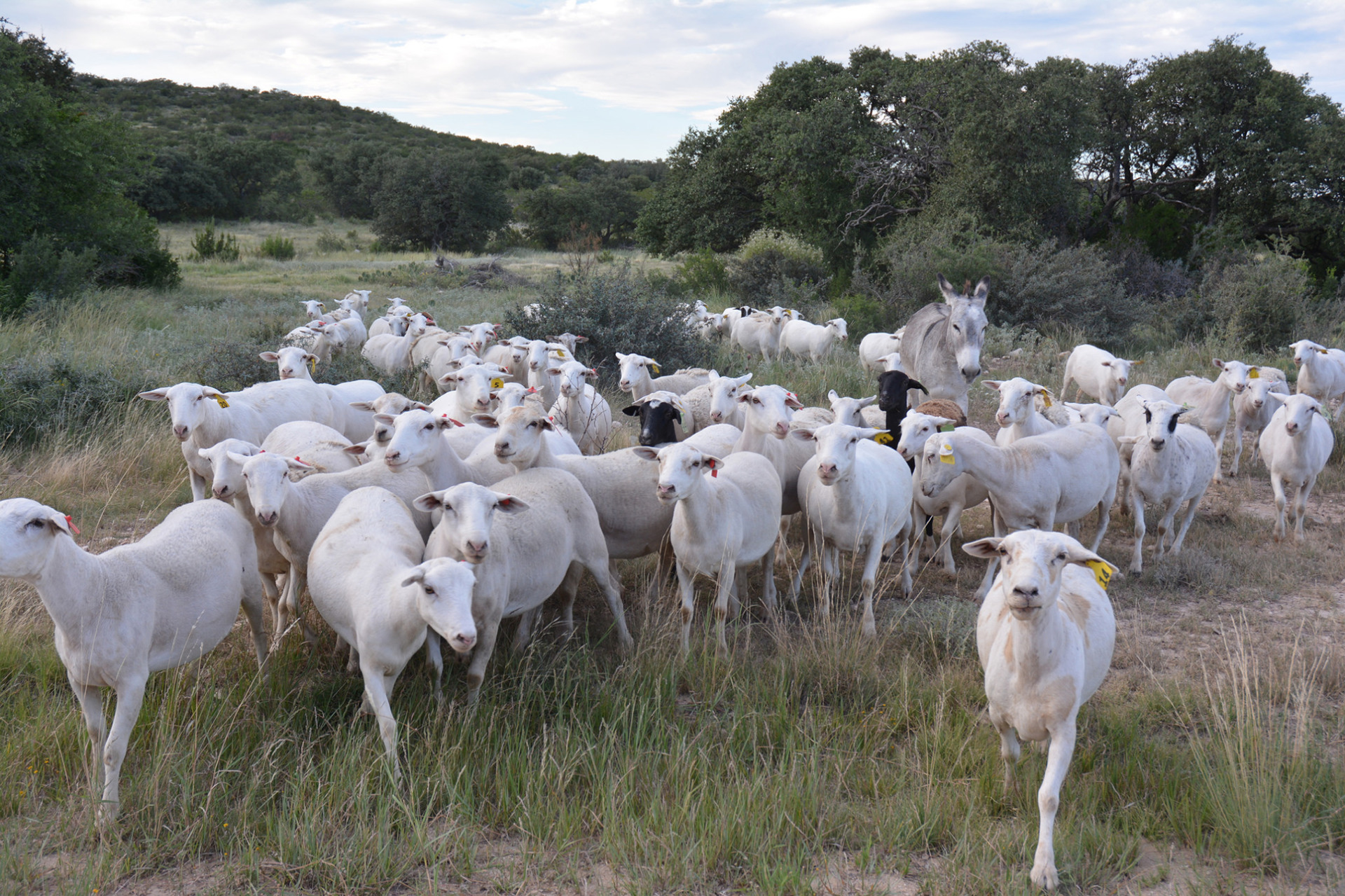Texas barbecue restaurant owners hear beef price forecast, discuss trends
Writer: Blair Fannin, 979-845-2259, [email protected]
Contacts: Dr. Jeff Savell, 979-845-3992, [email protected]
Dr. David Anderson, 979-845-4351, [email protected]
COLLEGE STATION – Texas barbecue restaurant owners and managers met recently at Texas A&M University in College Station for a town hall meeting discussing meat trends and issues.
The meeting was led by Dr. Jeff Savell, university distinguished professor, regents professor and E.M. “Manny” Rosenthal chairholder in the department of animal science at Texas A&M and holder of the Cintron University Professorship in Undergraduate Teaching Excellence.
He was joined by Dr. Davey Griffin, Texas A&M AgriLife Extension Service meat specialist, who gave an overview of certified beef programs and their requirements. He also led a cooler demonstration on brisket cuts and trends. Ray Riley, manager of the E.M. “Manny” Rosenthal Meat Science and Technology Center, provided discussion on meat trends.

The group, all part of the department of animal science at Texas A&M, has previously conducted a series of educational workshops to help further education in cooking Texas barbecue.
“Several of you have been up here (to College Station) for a lot of our meetings and workshops,” Savell said. “Almost everybody I’ve talked to when they got back home has changed something they’ve done. Some have changed how they are trimming briskets, changed their wood. We’ve also received a lot of questions about availability, grades … We decided, why don’t we have a meeting.”
Savell said the meeting was held on a Monday since it is a ‘dark day’ for most barbecue restaurants. The town hall meeting attracted close to 30 individuals who enjoyed prime rib sandwiches and home-prepared food for lunch.
One of the top issues discussed was the price of beef, particularly barbecue cuts such as brisket. To get a better understanding of what lies ahead with regards to pricing and availability, Dr. David Anderson, AgriLife Extension livestock economist, gave an outlook on the livestock markets for 2015.
Anderson said beef cattle prices are expected to remain on the upside (higher) as cattle producers continue to rebuild herds following drought of 2011. He said beef cattle inventories are at levels not seen since the 1950s and that herd expansion is a slow process.
“We’ve got the fewest cattle in decades, and that’s going to stay with us,” Anderson said. “It’s going to get even tighter as producers attempt to expand.”
Overall, Anderson said, trends in the market for 2015 are tight supplies of fed cattle and cows, but expansion is underway.
“We are looking at a couple of years before production increases,” he said. “You are looking at a longer time period for heifer production. The expansion is underway, which is going to take a couple of years for those heifers to mature and have calves. When you talk to rancher audiences, they really like this as it will keep prices high. Overall, there are two ways we are going to expand: We’ve got to quit killing cows and start holding back heifers.”

Anderson said in 2015 it’s likely there will be less beef production as cattle producers expand herds.

“As we hold more heifers back and turn them into cows having calves, that’s even less beef production. I think in 2015 we will have a few more cows than we did this year and in 2016 even more cows. But big droughts in big production areas of cows would hold us back further and keep us from being able to expand.”
Weekly prices for wholesale boneless, 90-percent lean beef have been priced at $3 per pound or $300 per hundredweight.
“There’s not much relief in sight with tight supplies of cattle,” Anderson said. “That’s coupled with slaughter steer prices of $1.72 per pound or $172 per hundredweight. We produce 23 billion pounds of beef here in the U.S. Itwould take 26 billion of pounds to get prices down to $210 per hundredweight or $2.10 per pound for fresh 90-percent lean weekly prices.”
In the meantime, barbecue restaurants will continue to pay premiums for cuts of brisket and other beef cuts used for menu items, he said.
Anderson said he projects higher pork production in 2015. The porcine epidemic diarrhea virus has led to less pork production in 2014.
“That’s resulted in fewer hogs, but we’ve had heavier weights (due to low feed costs),” Andersons said. “Expansion has already begun, fueled by prices and feed costs. It has started because it has been profitable to raise hogs,and I think we will have more pork in 2015.”
He also expects chicken production to increase in 2015.
“We had cold weather last winter, and that caused effects on placements and growout,” Anderson said. “There was delayed expansion due to reproduction issues. I think in 2015 we could see a heck of a lot more chicken, which consequently will lead to lower prices.”
Griffin gave an overview of the many certified beef programs that have product in the retail meat case. He said these programs are gaining more popularity among consumers. Griffin said in the past, it was the assumption the customer knew the grocery retailer had control of the product since it left the farm.
“Today’s beef consumer is much more brand conscious than ever before,” he said. “Now customers are coming in and looking for a beef product that is associated with a brand name.”
Griffin also provided a demonstration of trends in brisket cuts before attendees.
For more information about Texas barbecue, visit http://bbq.tamu.edu/ .





